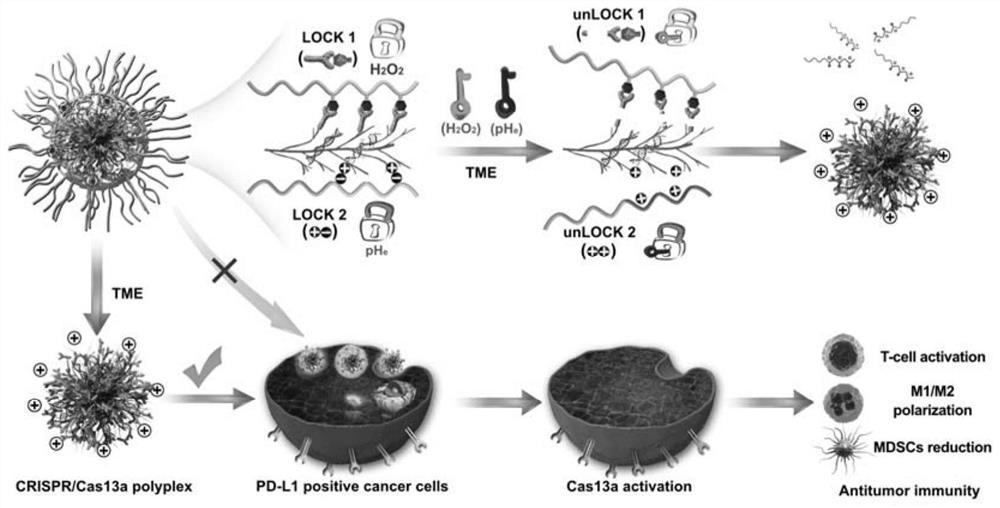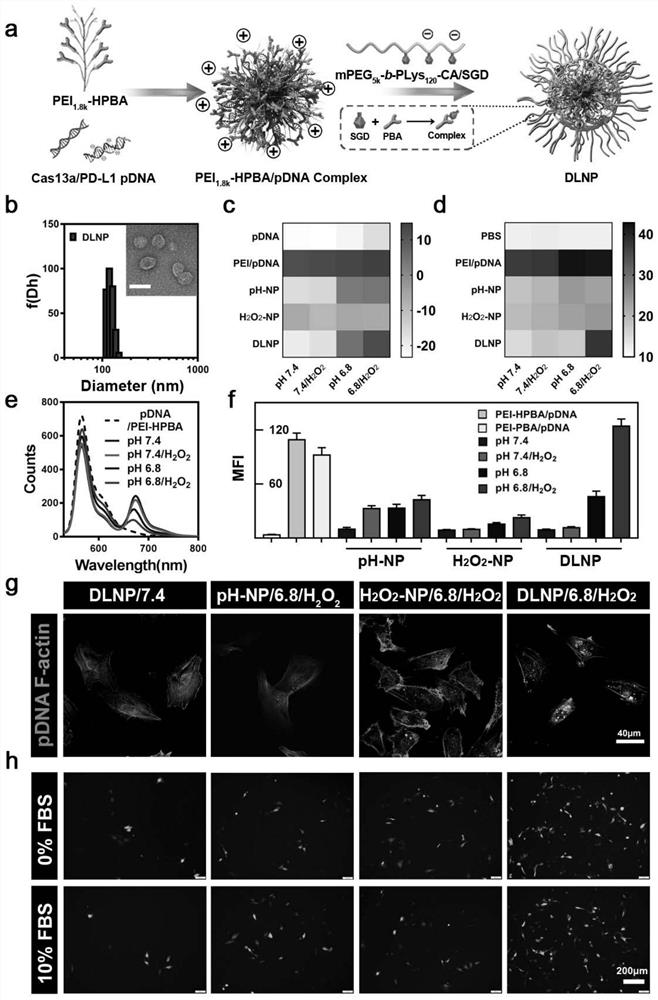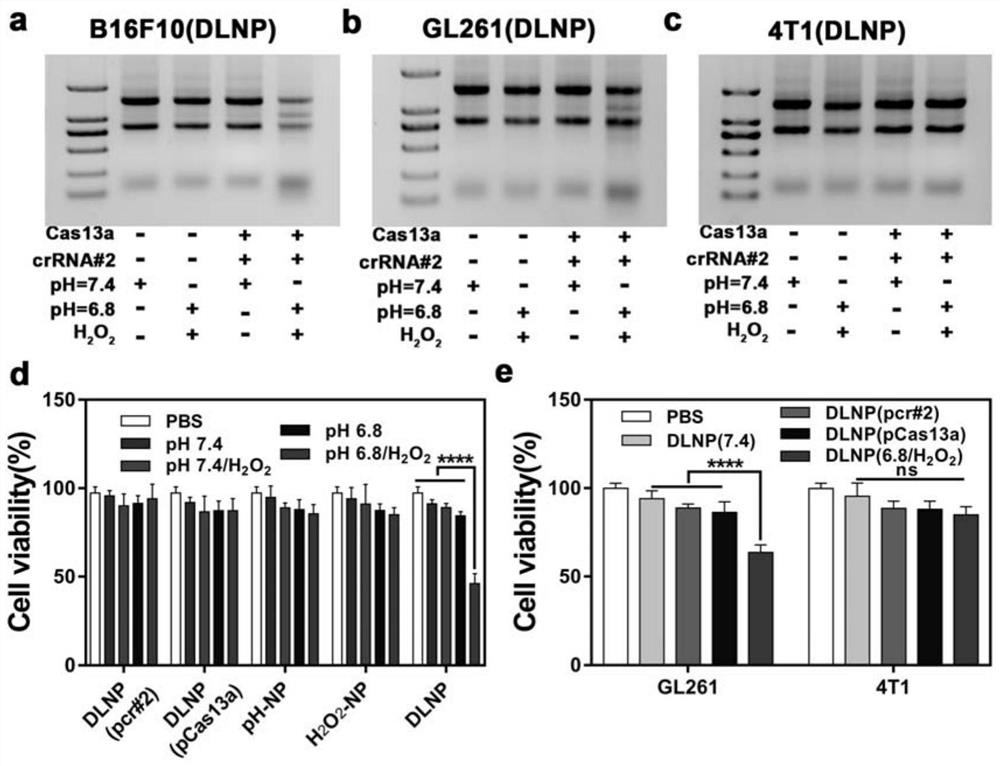Preparation method and application of a double-locked nanoparticle that can restrict activation of CRISPR/Cas13a
A nanoparticle and double lock technology, applied in the field of biomedicine, can solve problems such as toxic and side effects, and achieve the effects of reducing toxic and side effects, easy to popularize and apply, and excellent in blood circulation stability.
- Summary
- Abstract
- Description
- Claims
- Application Information
AI Technical Summary
Problems solved by technology
Method used
Image
Examples
Embodiment 1
[0035] attached figure 1 A functional schematic diagram of the double-locked nanoparticles of the present invention is shown, and the particle size of the double-locked nanoparticles prepared by the method of the present invention is 128.9±13.93 nm. DLNP can maintain excellent blood circulation stability in blood. DLNP can only work in the presence of both low pH and high H 2 O 2 The release of the CRISPR / Cas13a system in a high concentration of tumor microenvironment can significantly reduce the toxic and side effects of the CRISPR / Cas13a system.
[0036] see attached figure 1 , the preparation method of the double-locked nanoparticle that restricts activation of CRISPR / Cas13a system of the present invention comprises the following steps:
[0037] 1) PEI 1.8k - Synthesis of HPBA / pDNA,
[0038] pre-prepared PEI 1.8k -HPBA 2.0 Dissolved in 10 mM phosphate buffered saline (PBS) to prepare a 1 mg / ml solution, the plasmid DNA (pDNA) encoding the CRISPR / Cas13a system was mi...
Embodiment 2
[0053] Example 2: Observation of double-locked nanoparticles in pHe / H 2 O 2 Dual responsiveness applications.
[0054] To better evaluate the pHe / H of DLNP 2 O 2 Dual-responsive, two types of contrasting nanoparticles were prepared following a similar approach to DLNP, i.e. non-pH but H 2 O 2 Responsive nanoparticles (denoted as H 2 O 2 -NP) and non-H 2 O 2 But pH-responsive nanoparticles (denoted as pH-NPs).
[0055] For zeta potential analysis, first pDNA, PEI 1.8k -HPBA / pDNA, DLNP, H 2 O 2 -NP and pH-NP (50 μg / mL pDNA, 2 mL) at 37°C under different conditions (pH 7.4, pH 7.4 / H 2 O 2 , pH 6.8, pH 6.8 / H 2 O 2 ) for 8 hours. The culture broth was then exchanged with PBS (10 mM, 7.4) by centrifugal ultrafiltration, followed by zeta potential testing.
[0056] For nonspecific protein adsorption analysis, first pDNA, PEI 1.8k -HPBA / pDNA, DLNP, H 2 O 2 -NP and pH-NP (50 μg / mL pDNA, 2 mL) at 37°C under different conditions (pH 7.4, pH 7.4 / H 2 O 2 , pH 6.8, pH 6....
Embodiment 3
[0060] Example 3: Observation of the application of double-locked nanoparticles in cellular uptake and gene transfection
[0061] For CLSM observations, U87 cells were grown at 1 × 10 per well prior to co-culture with nanoparticles 5 A density of individual cells was seeded in 35 mm confocal dishes (Φ=15 mm) and incubated for one day. Then the same amount of YOYO-1-labeled DLNP, H 2 O 2 -NP and pH-NP (1 μg pDNA) were added to the cells and in complete medium under different conditions (pH 7.4, pH 7.4 / H 2 O 2 , pH 6.8, pH 6.8 / H 2 O 2 ) for 2 hours. Subsequently, cells were rinsed with ice-cold PBS and fixed with fresh 4% paraformaldehyde for 15 min at room temperature. Nuclei were further stained with DAPI and rhodamine phalloidin for cellular actin according to the manufacturer's protocol. CLSM images were taken on an Olympus CLSM with a ×60 objective.
[0062] For FACS-based assays, U87 cells were grown at 1 × 10 per well prior to co-culture with nanoparticles 5 1 c...
PUM
| Property | Measurement | Unit |
|---|---|---|
| particle diameter | aaaaa | aaaaa |
Abstract
Description
Claims
Application Information
 Login to view more
Login to view more - R&D Engineer
- R&D Manager
- IP Professional
- Industry Leading Data Capabilities
- Powerful AI technology
- Patent DNA Extraction
Browse by: Latest US Patents, China's latest patents, Technical Efficacy Thesaurus, Application Domain, Technology Topic.
© 2024 PatSnap. All rights reserved.Legal|Privacy policy|Modern Slavery Act Transparency Statement|Sitemap



